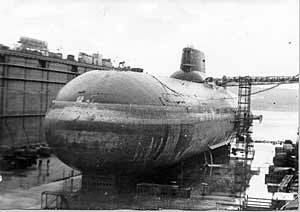
New Managing Director for Bellona Norway
The Board of the Bellona Foundation has appointed former Minister of Climate and the Environment Sveinung Rotevatn as Managing Director of Bellona No...
News

Publish date: October 18, 2018
News
It took about 25 years of Russian elbow grease and billions of dollars in foreign funding, but as of six years ago, the dilapidated remains of the once-feared Soviet nuclear submarine fleet, one of the gravest environmental threats facing Northwest Russia and the world, was finally dismantled.
All but a few pieces, that is.
What has remained of the fearsome Cold Warriors, after they were cut to pieces by enormous saws and their spent nuclear fuel sent to safer storage, was a flotilla of irradiated reactor compartments, held buoyant in enormous steel cylinders at piers along Russia’s Arctic coast.
While not as dangerous as the used uranium at their cores, the submarine reactor compartments were still highly radioactive, and required storage at Sayda Bay a former military facility near Murmansk, which was retrofitted to keep them safe.
And now the last three of those compartments will finally be taken off the water and put onshore for storage by the end of next year, the semi-official Russian newspaper Izvestiya reports this week– marking a quiet end to one of the most dramatic, and contentious, international nuclear security efforts ever.
At the height of their power, the Soviet Navy’s 200 nuclear submarines were the terror of the Cold War seas, able to submerge for months at a time and approach targets with little warning. For decades they played hide and seek with their American counterparts as the two sides sought to outdo each other in stealth and firepower.
Yet the Russians always seemed to have the upper hand. Moscow out-produced the US in the sheer number of nuclear submarines it had and their drive systems were sneakier, allowing them to operate in near silence as they shadowed their rivals through undersea canyons and poked their conning towers up near places like Cony Island and Cape Cod before submerging again and vanishing.
These disappearing acts were one of the central fears driving Washington’s nuclear efforts, and American schoolchildren were for decades taught how to shelter under their desks lest one of these submarines shower the country with nuclear warheads from a sly perch off the US coast.
 Sayda Bay.
Credit: vestnikatomproma.ru
Sayda Bay.
Credit: vestnikatomproma.ru
When the Soviet Union suddenly dissolved in 1991, the vast majority of these submarines were parked at dockside and largely left to rust, presenting the world with a nuclear threat of a different kind.
Throughout the 1990s one desperate report after another emerged on the deteriorating condition of the once mighty submarines. Nearly all of them still had their nuclear fuel aboard but the Russian military, laid low by the economic chaos of the day, was out of money to take care of them.
The subs needed compressed air to keep them afloat, but time and again, the power company would shut of their electricity over the Navy’s unpaid bills. But keeping them afloat was vital. It was only way to prevent their reactors from becoming waterlogged and possibly sparking a chain reaction – and a nuclear blast off the coast of Murmansk, a city of 300,000.
 Russian submarines being dismantled.
Credit: US Department of Defense
Russian submarines being dismantled.
Credit: US Department of Defense
The situation was critical. Yet how could a navy –– which at one point publically begged Russia’s citizens for potatoes to feed its unpaid sailors –– hope to grapple with the cost of safely decommissioning its submarines?
In 1995, a former Soviet submarine captain named Alexander Nikitin joined with Bellona to produce a report called” The Russian Northern Fleet: Sources of Radioactive Contamination,” which showed the world exactly how bad things had gotten.
But Moscow wasn’t anxious for the news to get out. In the vulnerable throes of its lost empire, the Kremlin launched an offensive against Nikitin, prosecuting him as a spy for his efforts to summon help.
Yet by the time he was acquitted in 2000, the report he co-authored had become a guidebook for American and European funding efforts to help safely dispose of the nuclear might that had become Russia’s environmental Achilles’ heel.
Now the last remains of these submarines – three enormous red barrels containing reactor compartments – will finally join 117 others at the onshore storage at Sayda Bay.
There they will sit on a concrete slab for the next few decades to come, until their radiation has abated enough for them to be cut up yet again and put into geologic storage.
But here another waiting game begins. Russia has only just begun to investigate cites suitable for the long-term underground storage of nuclear waste. So while the Soviet Navy is now a thing of the past, its grave has yet to be truly dug.

The Board of the Bellona Foundation has appointed former Minister of Climate and the Environment Sveinung Rotevatn as Managing Director of Bellona No...

Økokrim, Norway’s authority for investigating and prosecuting economic and environmental crime, has imposed a record fine on Equinor following a comp...

Our op-ed originally appeared in The Moscow Times. For more than three decades, Russia has been burdened with the remains of the Soviet ...

The United Nation’s COP30 global climate negotiations in Belém, Brazil ended this weekend with a watered-down resolution that failed to halt deforest...